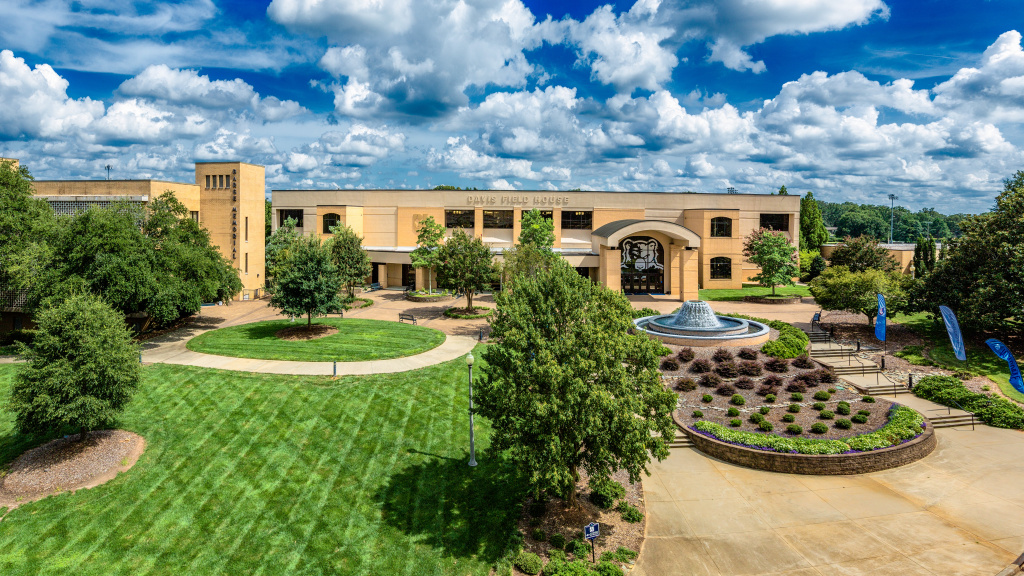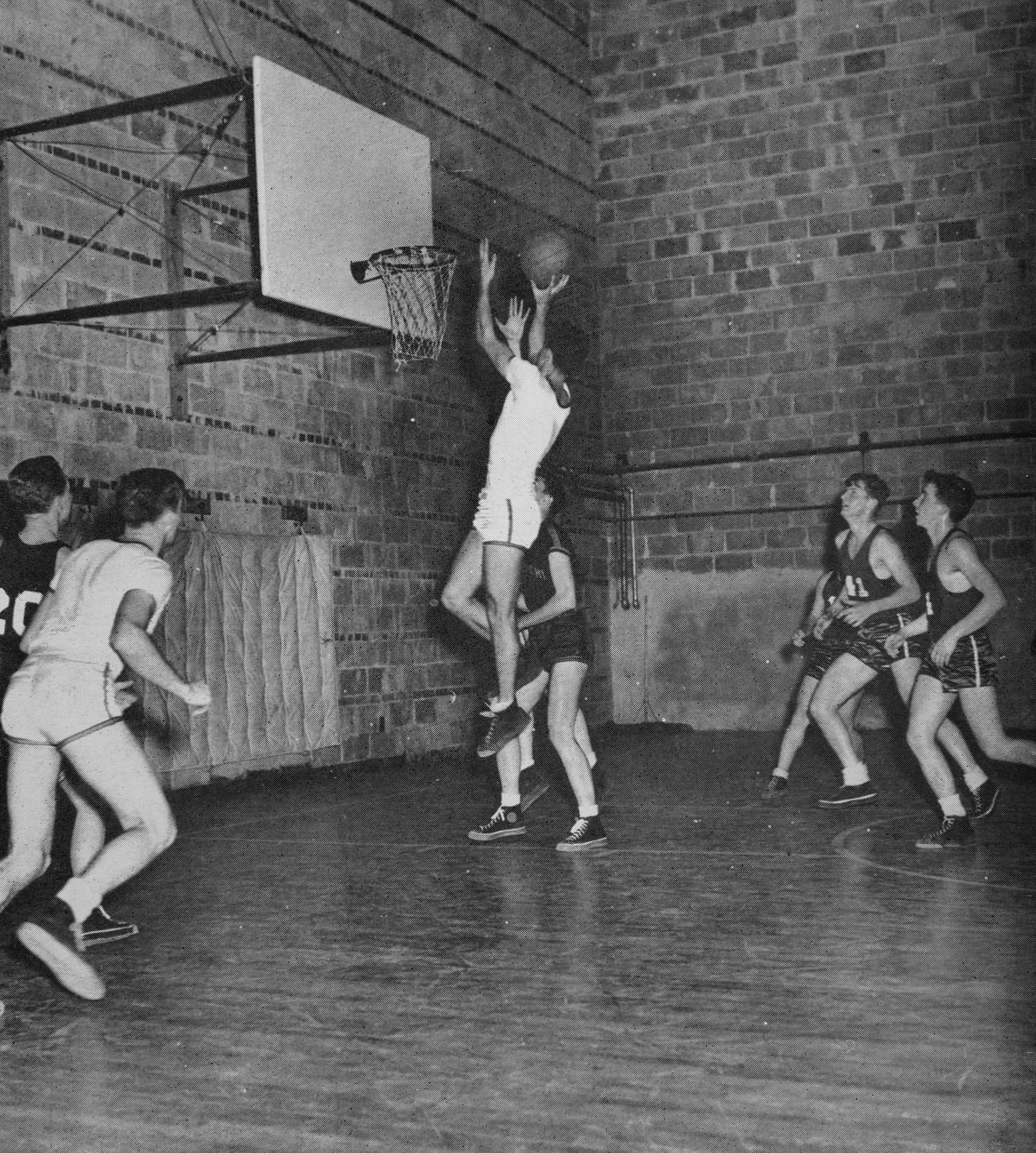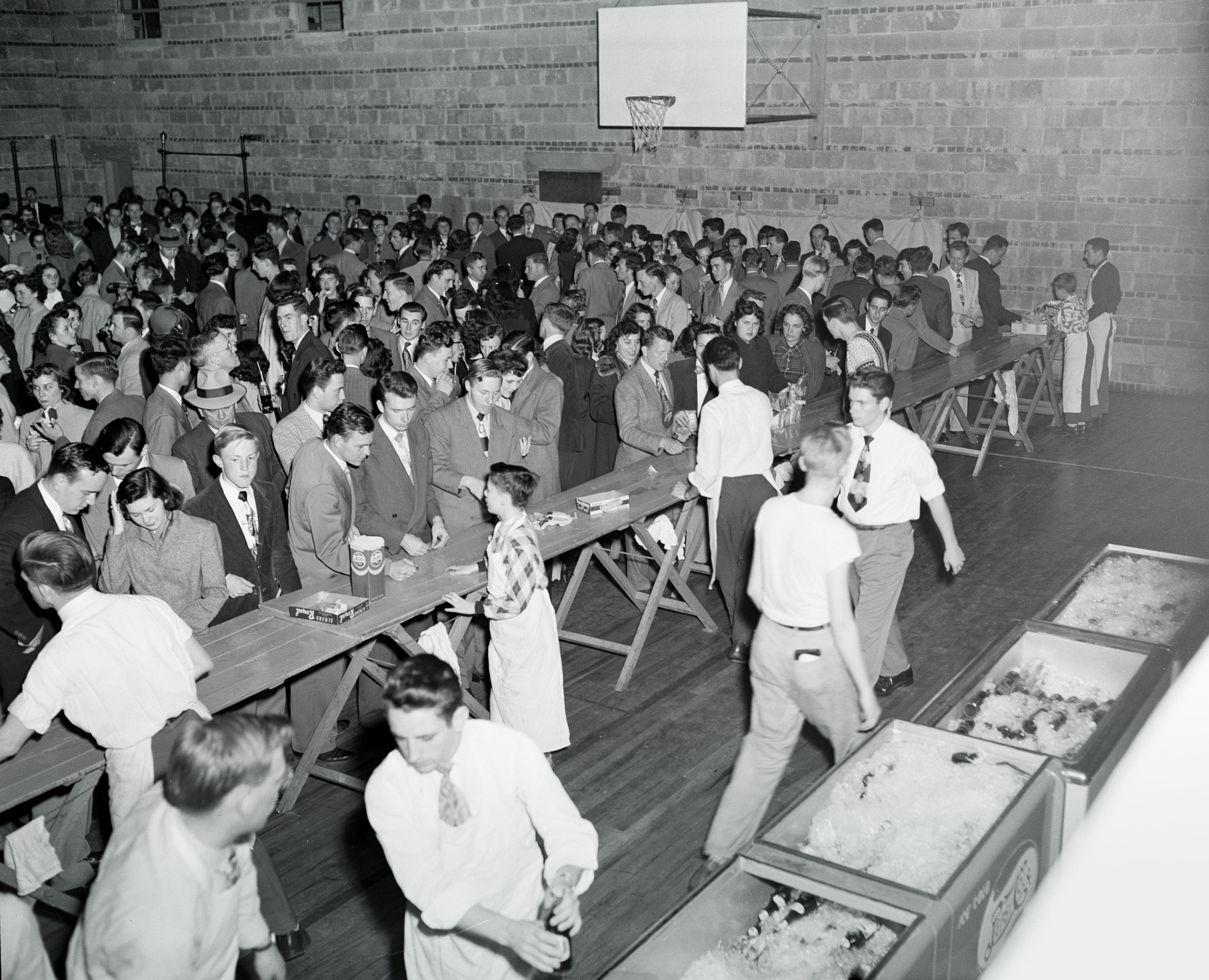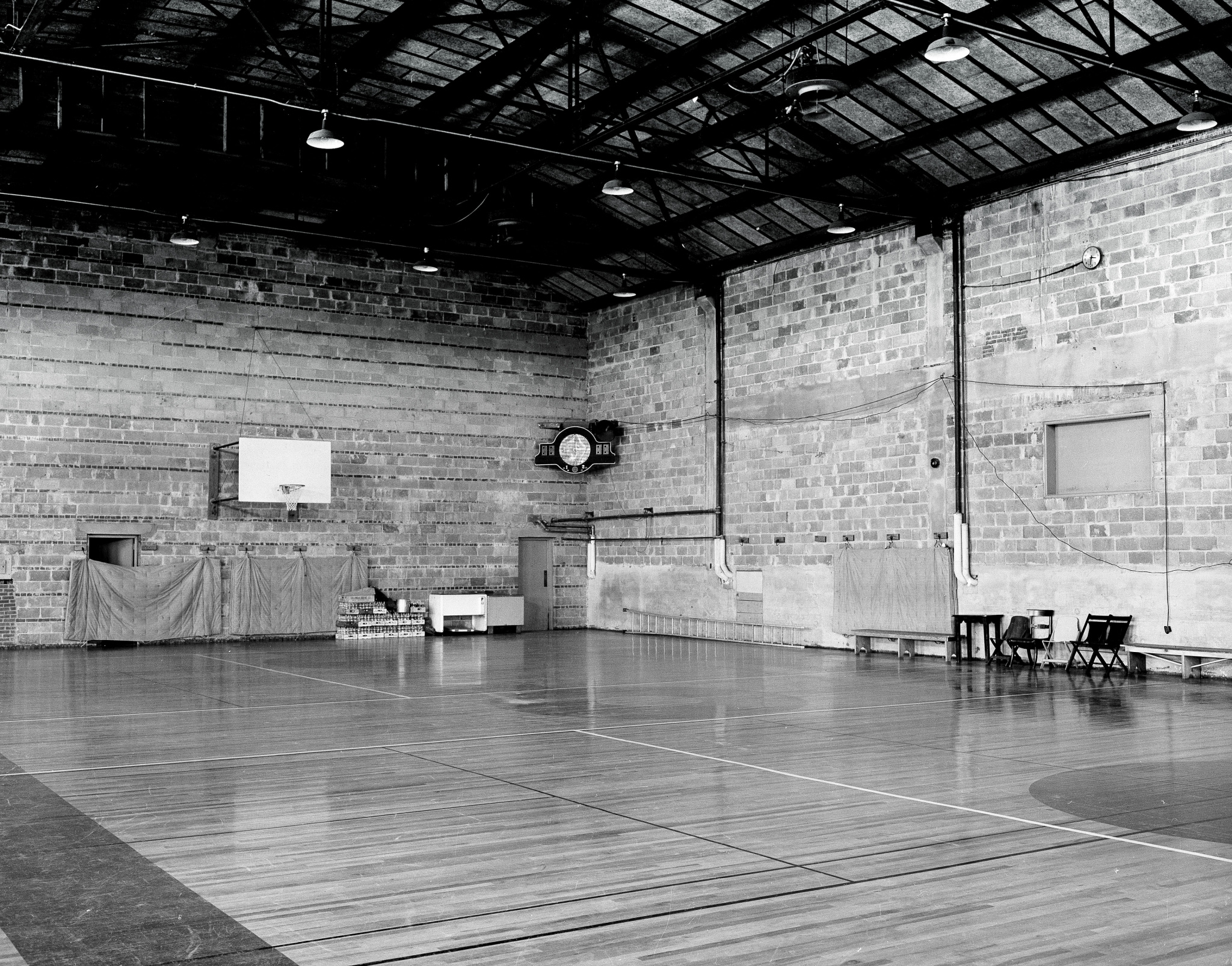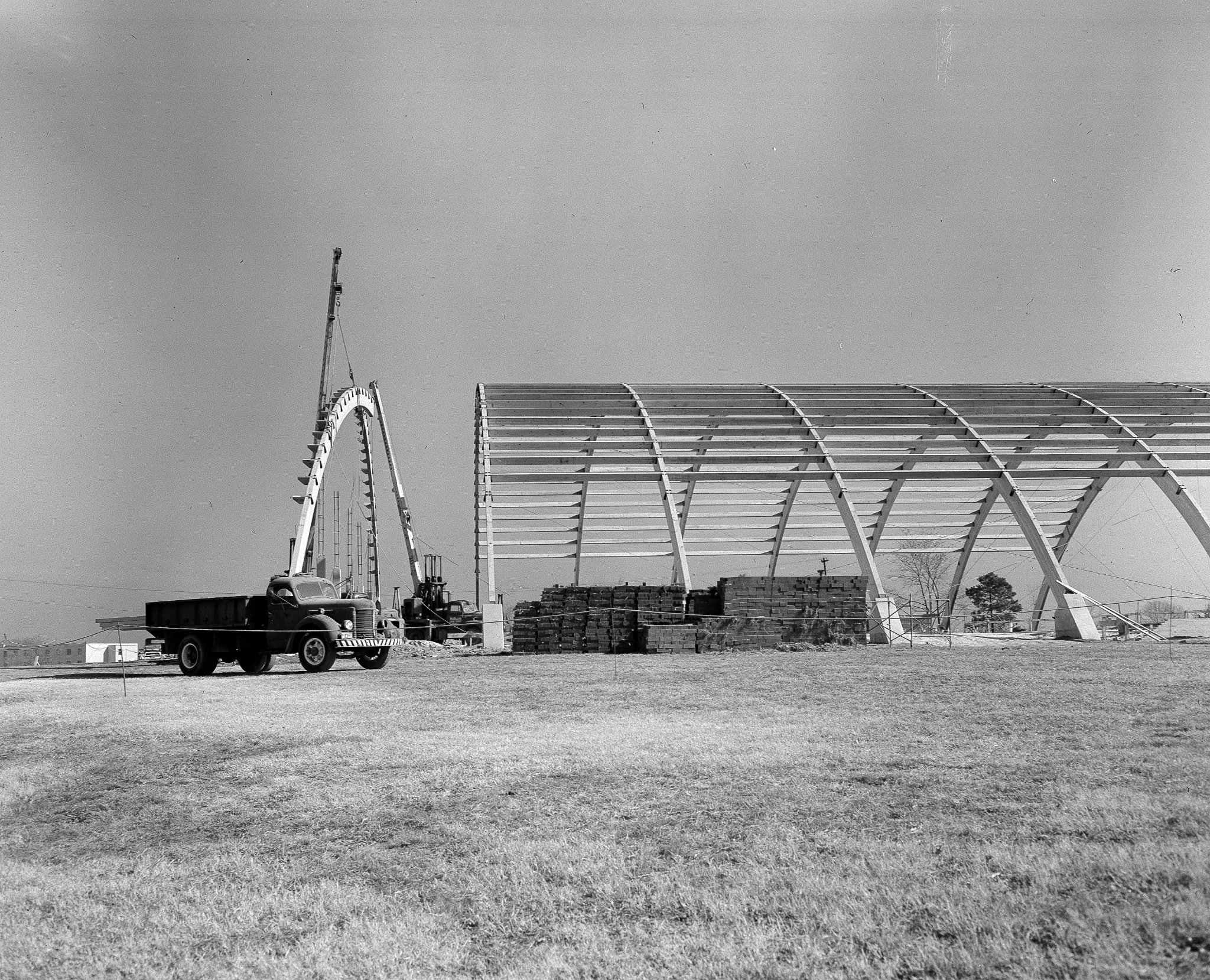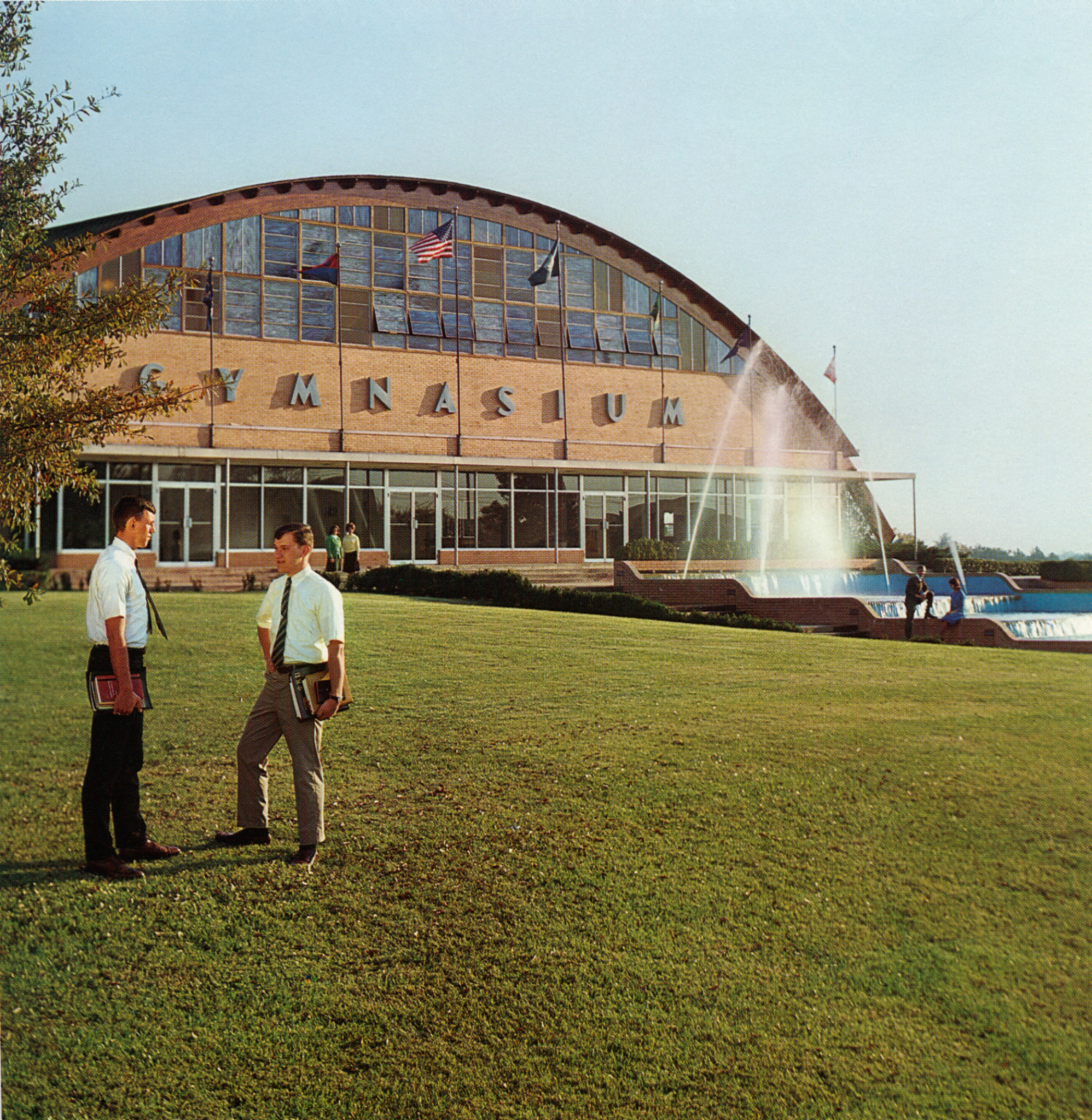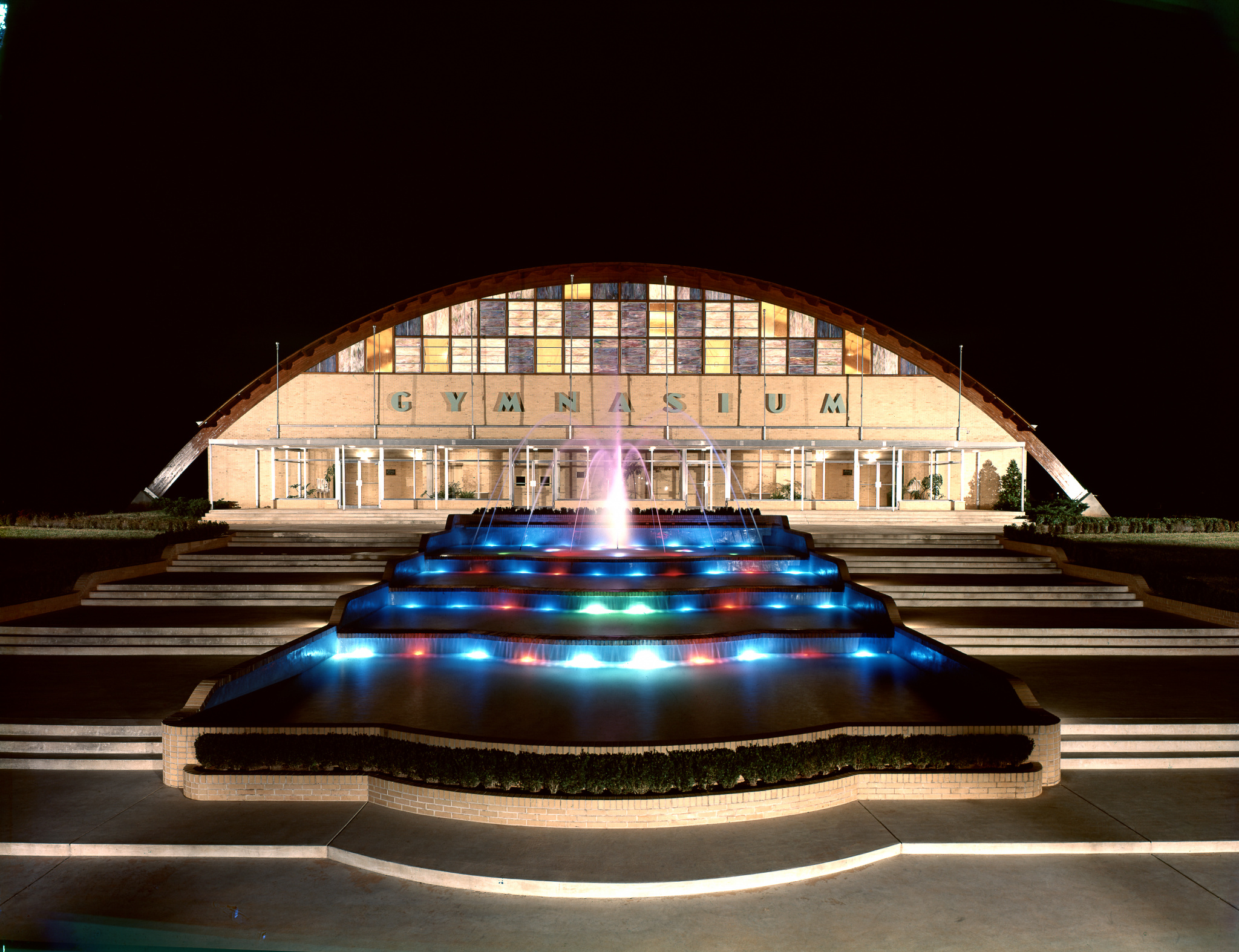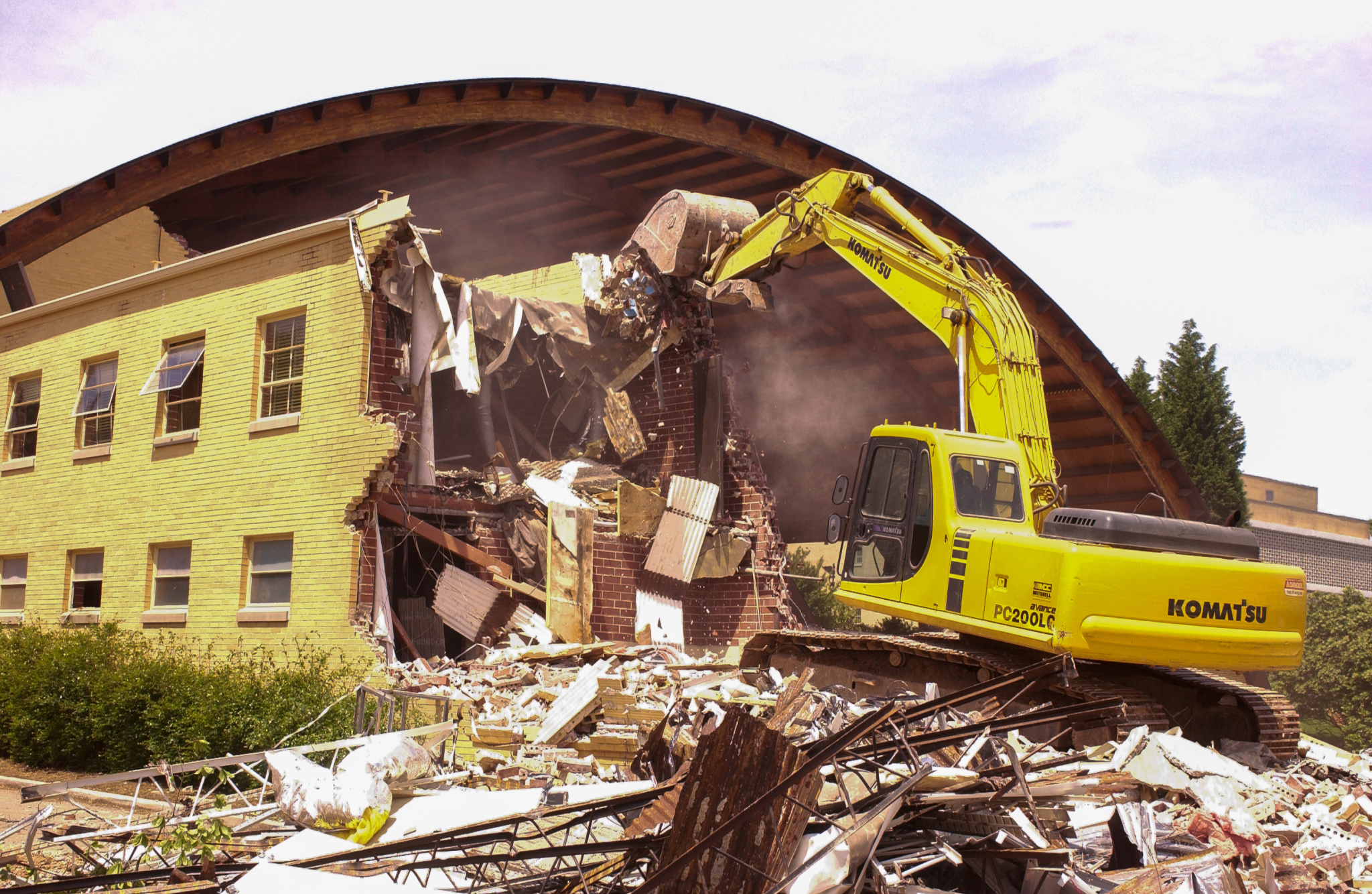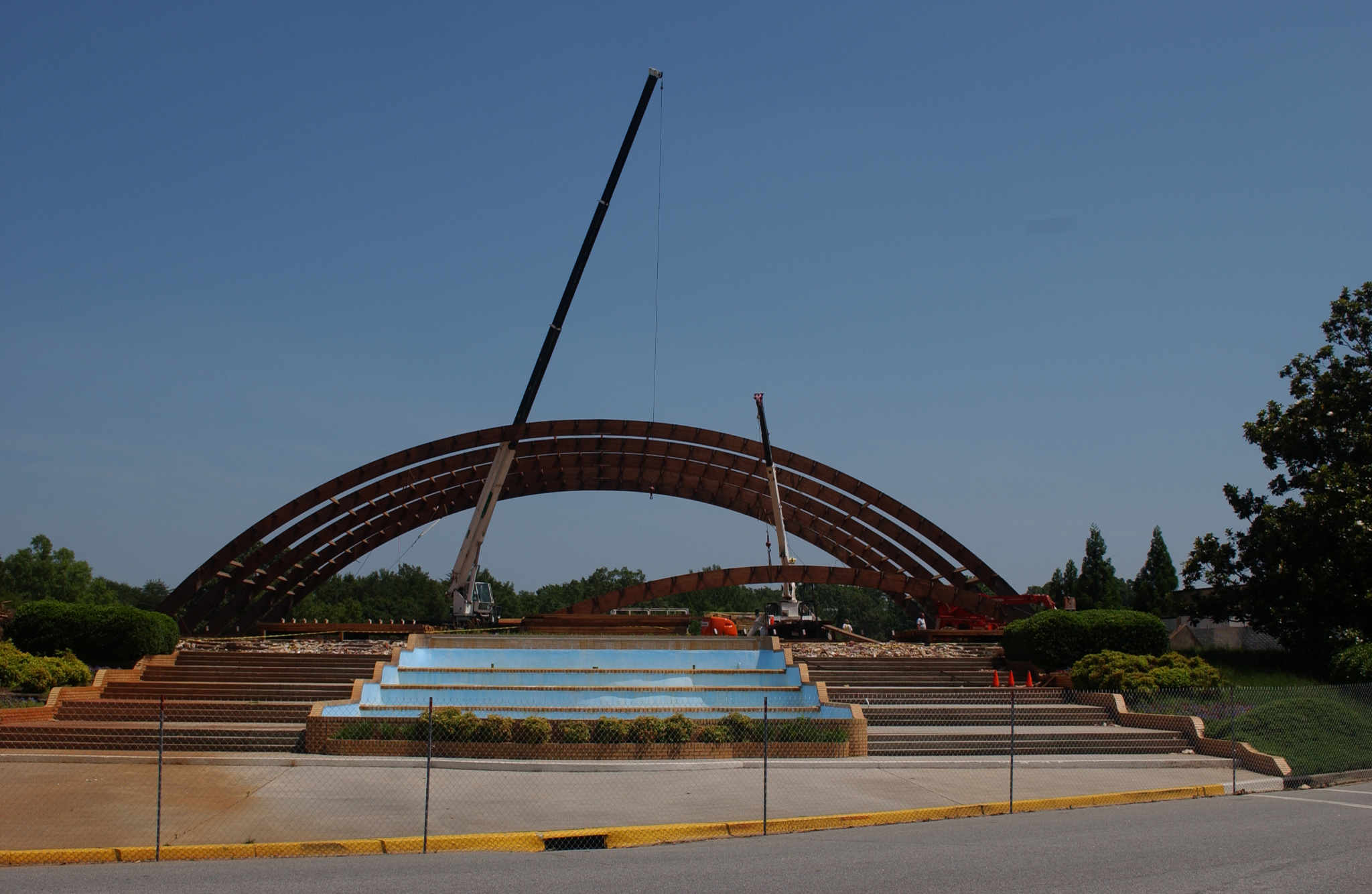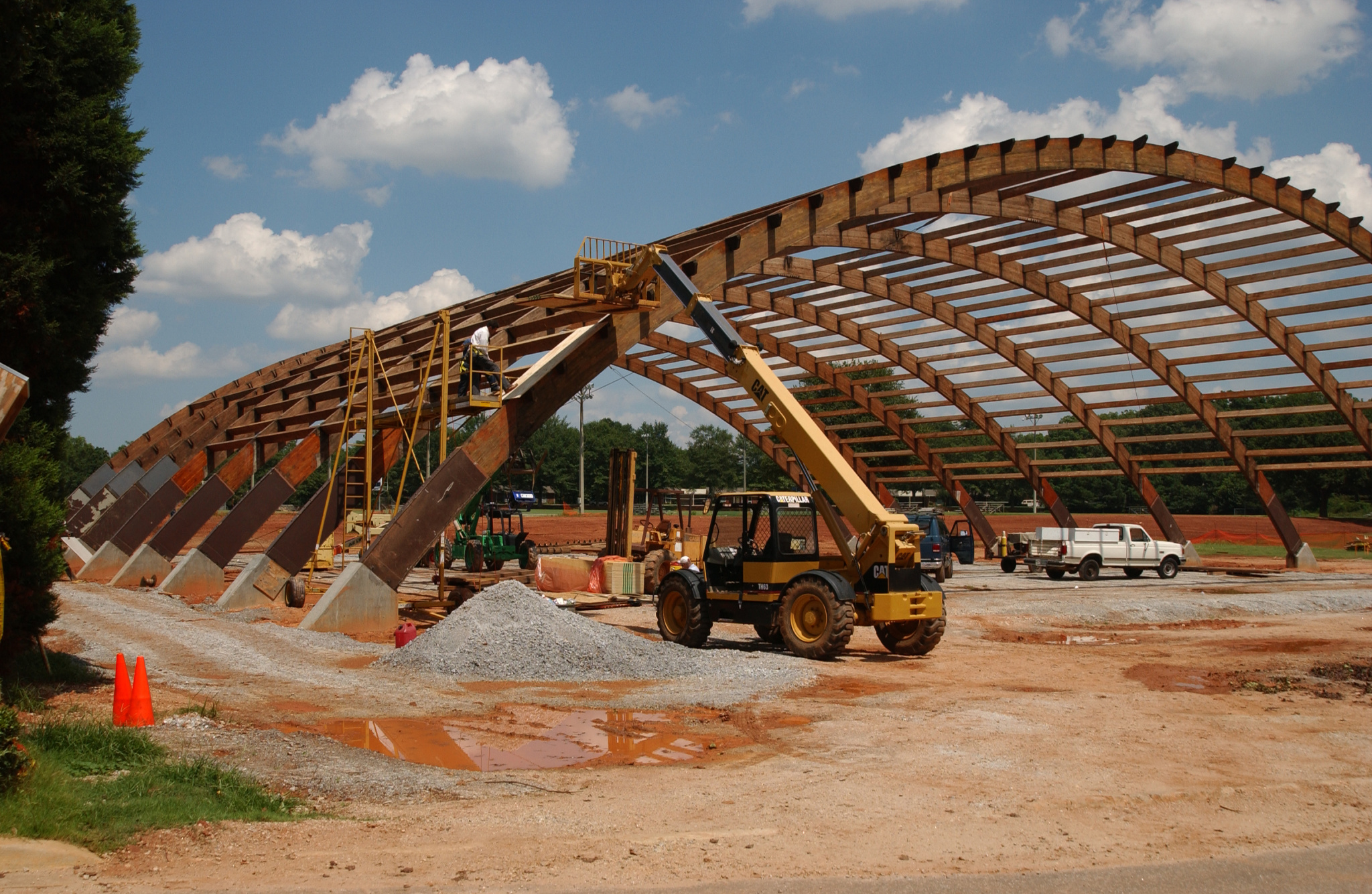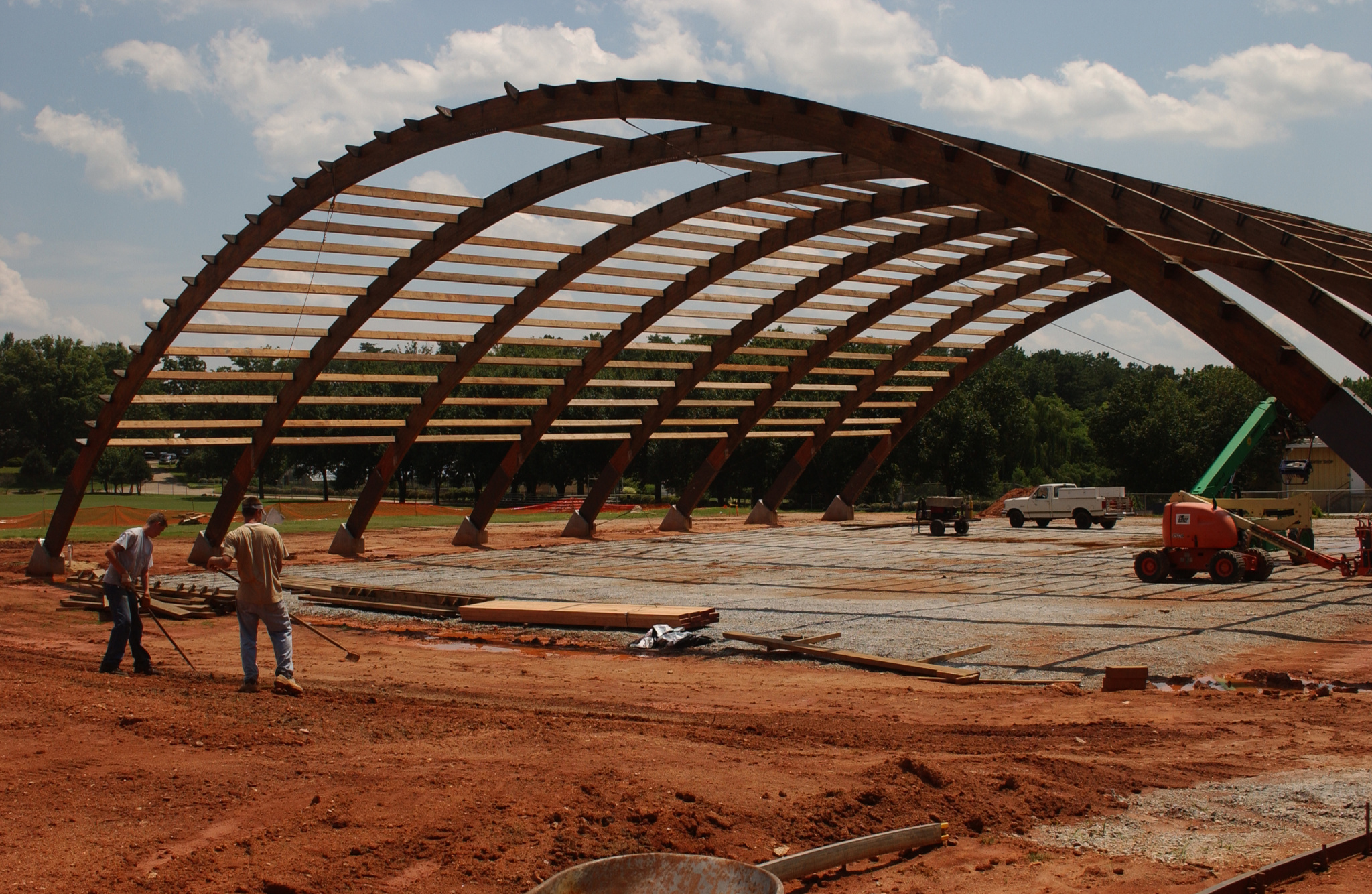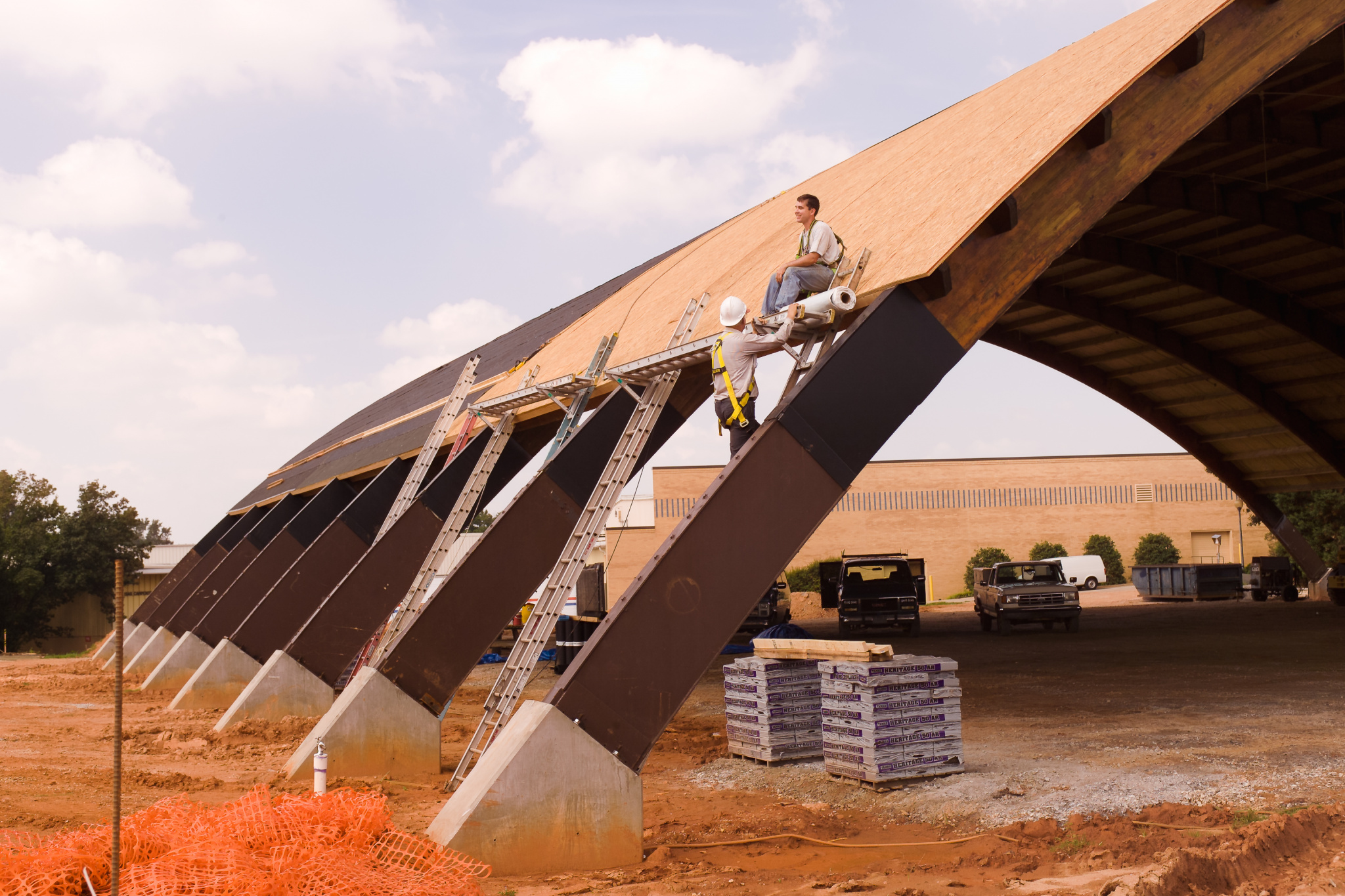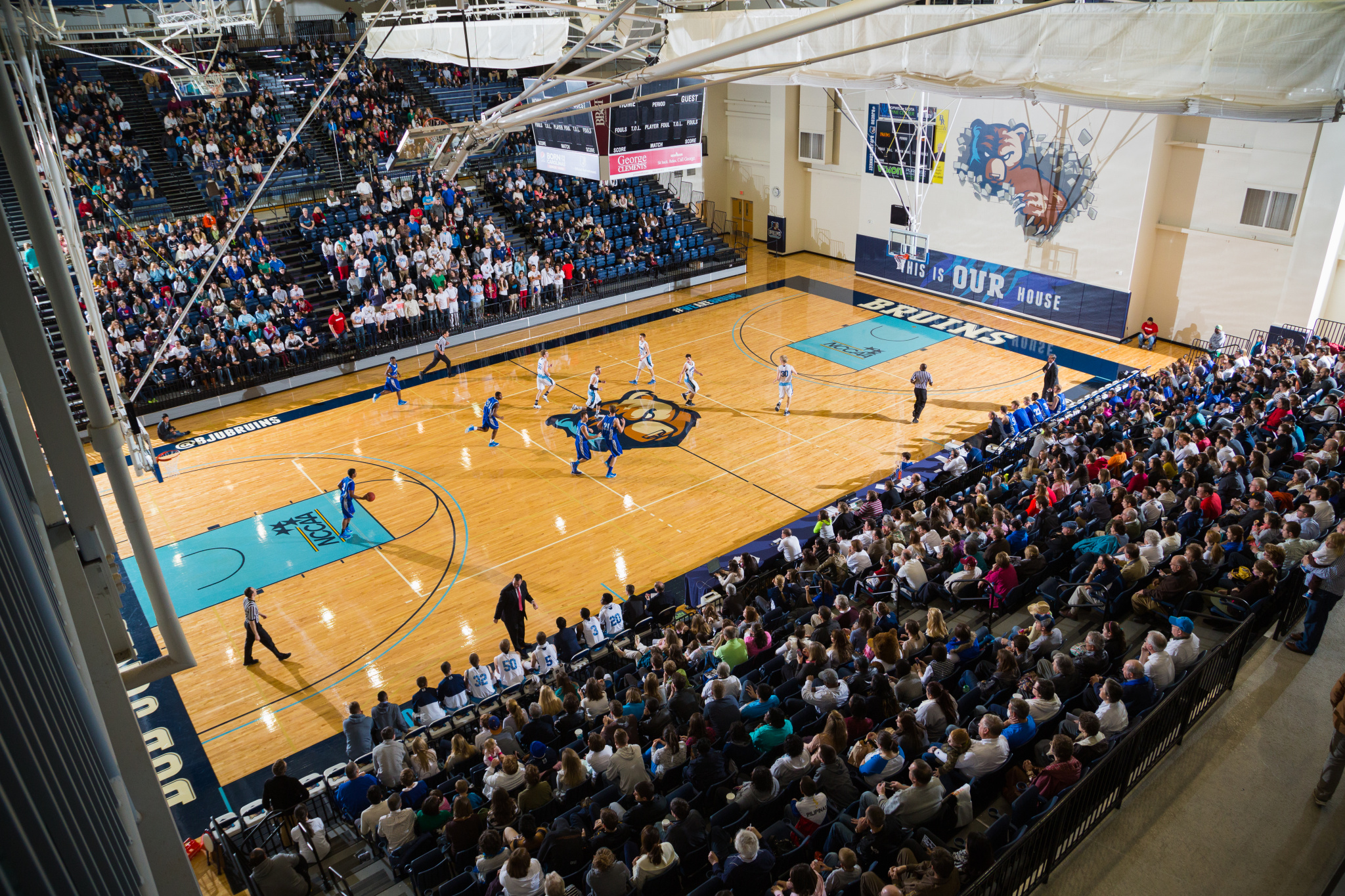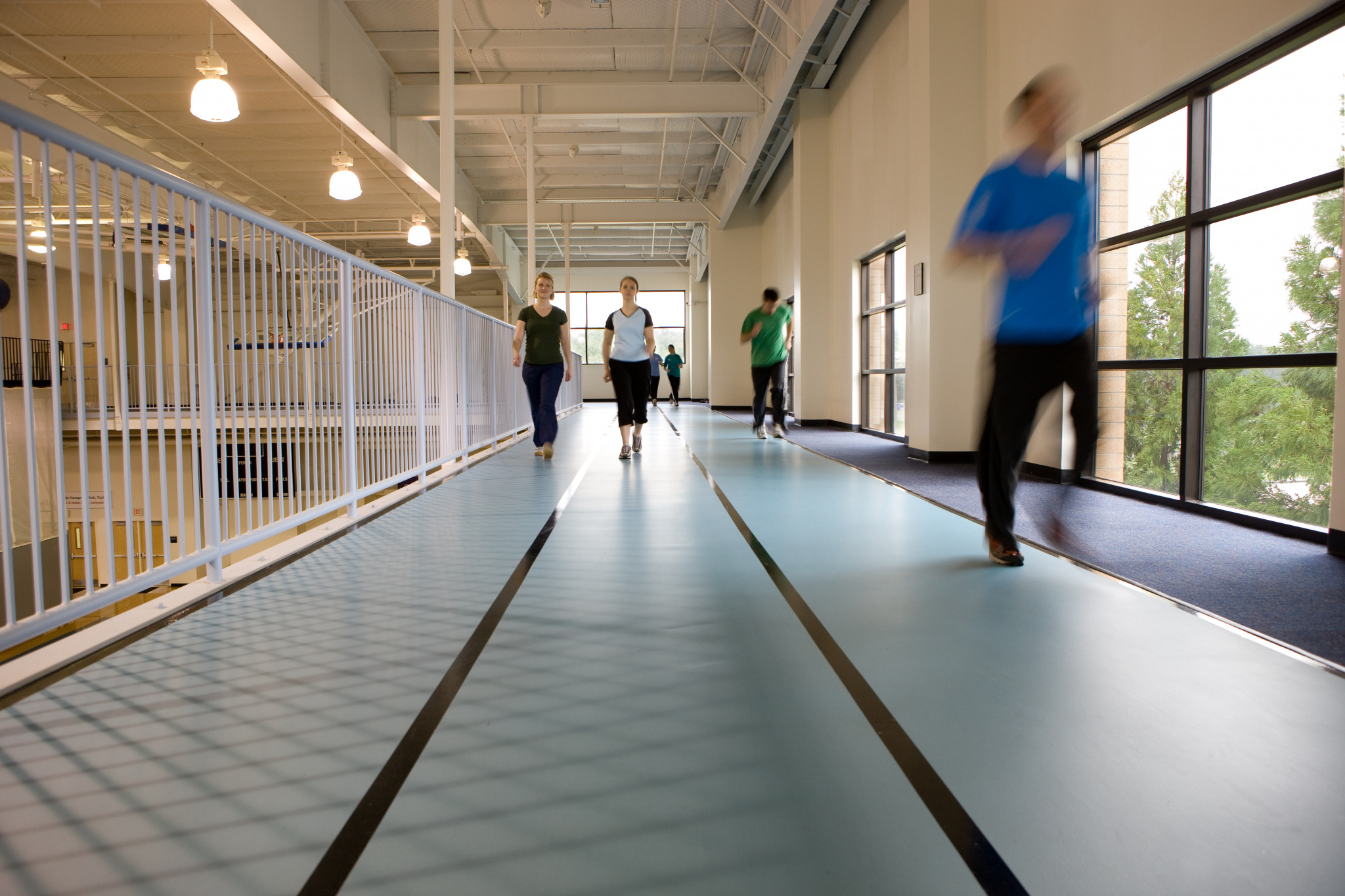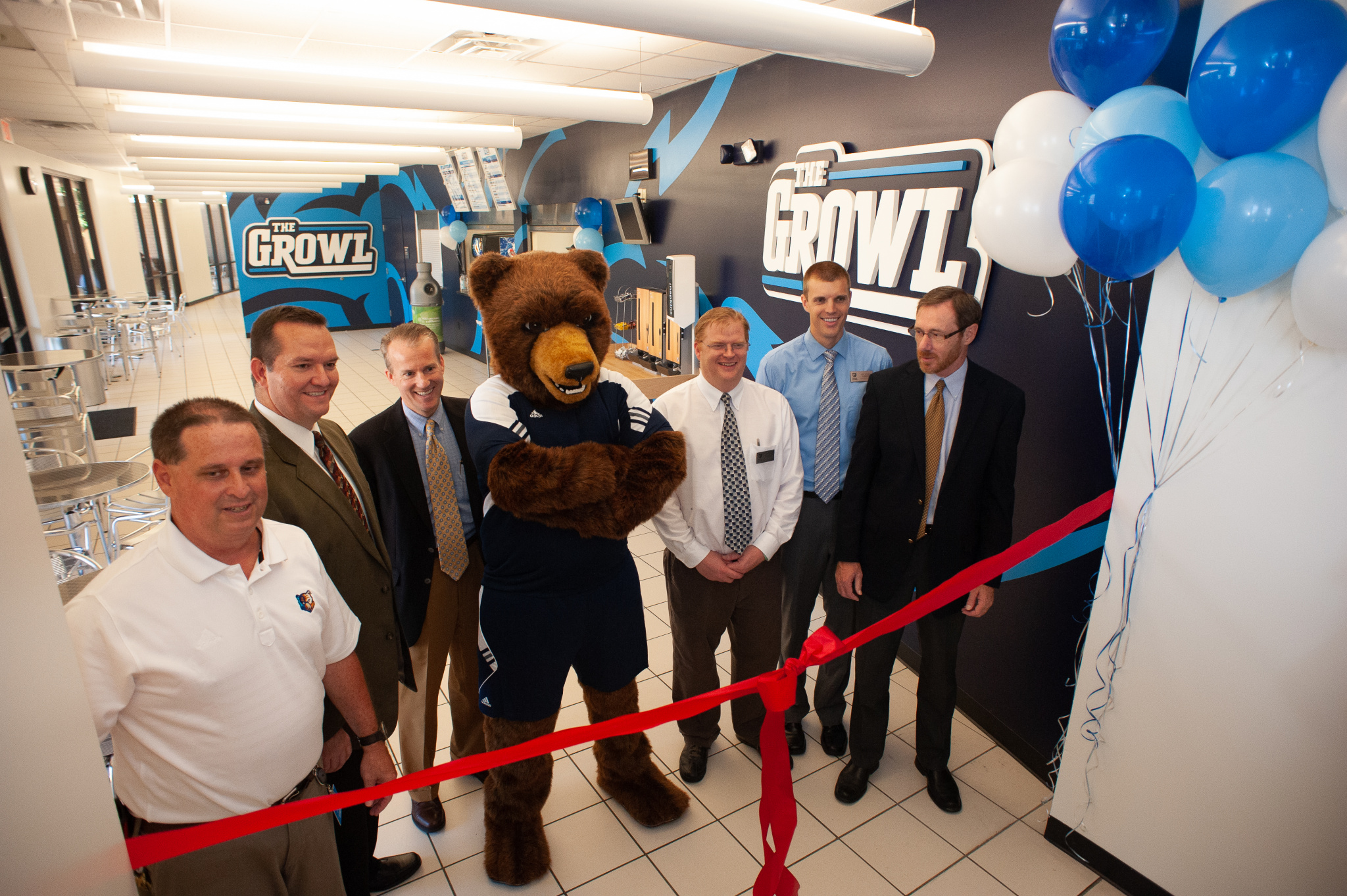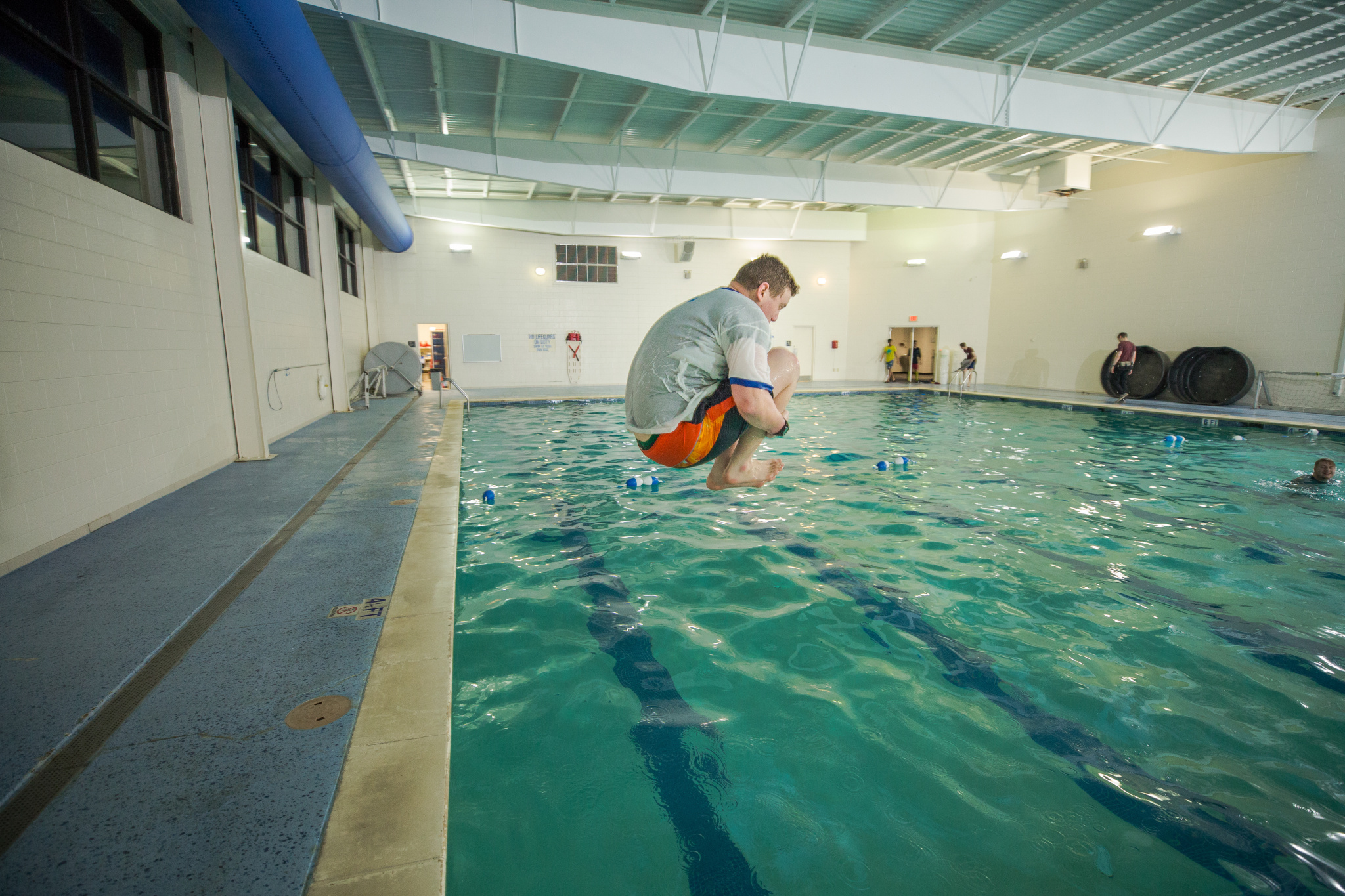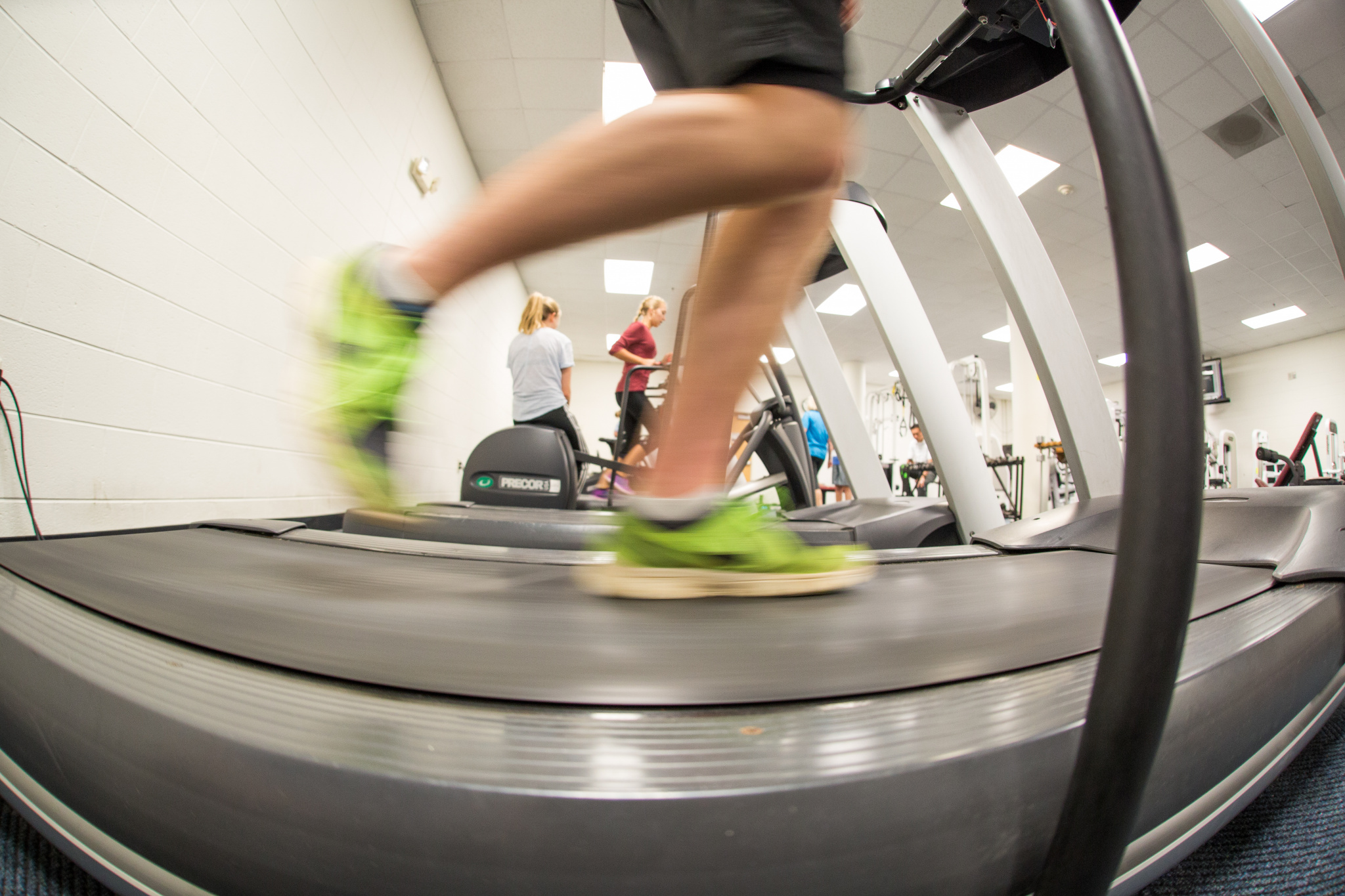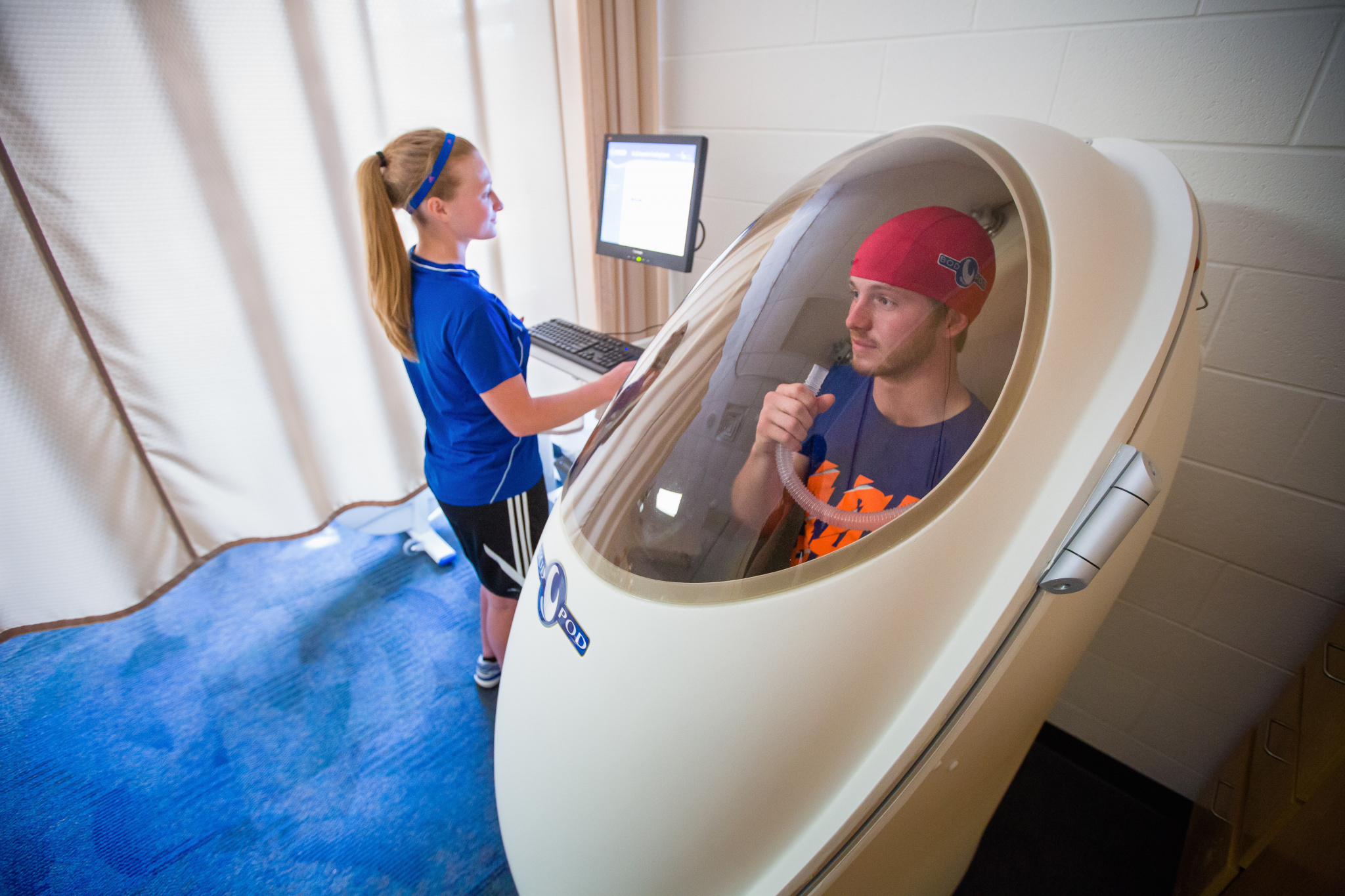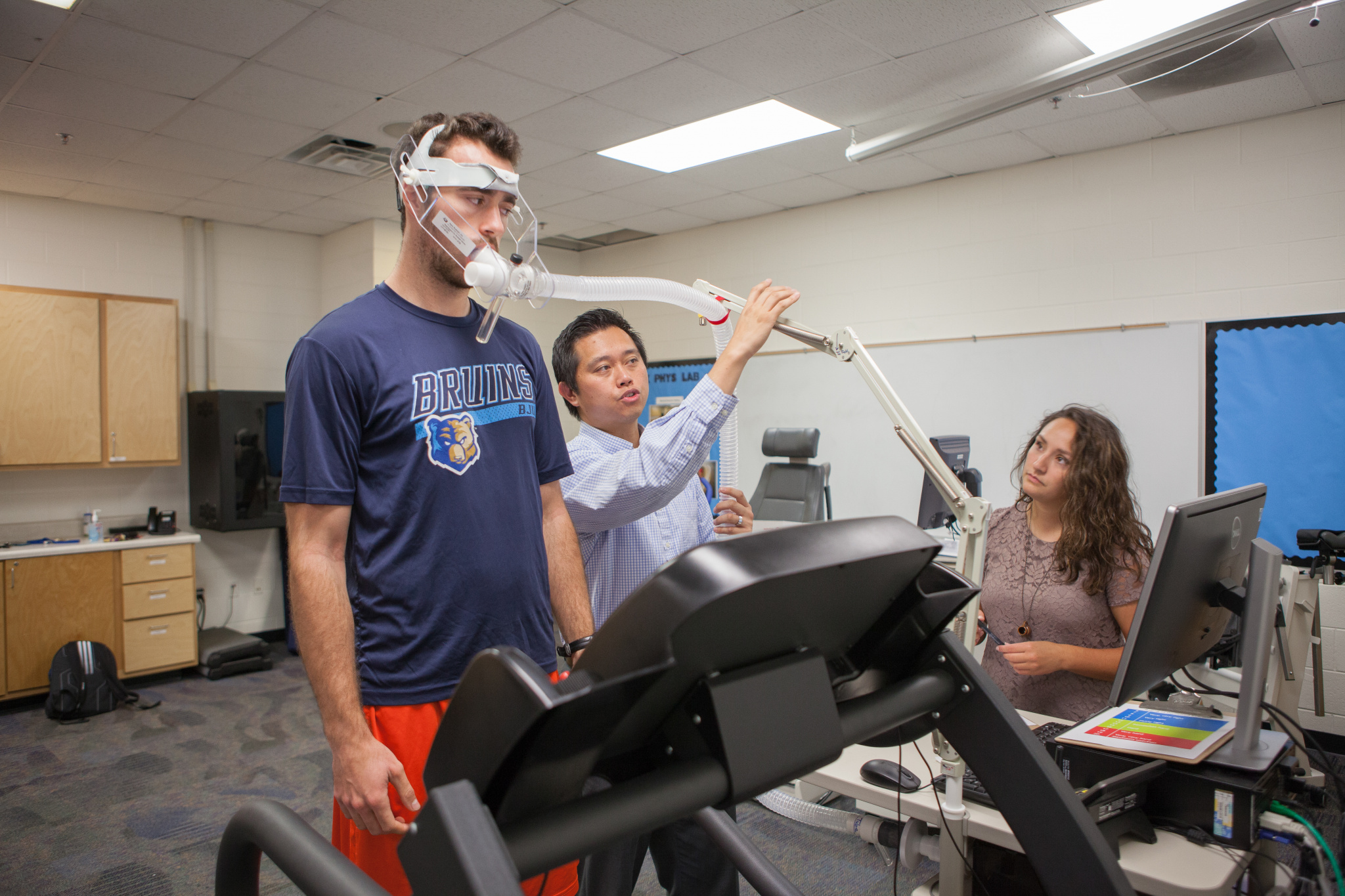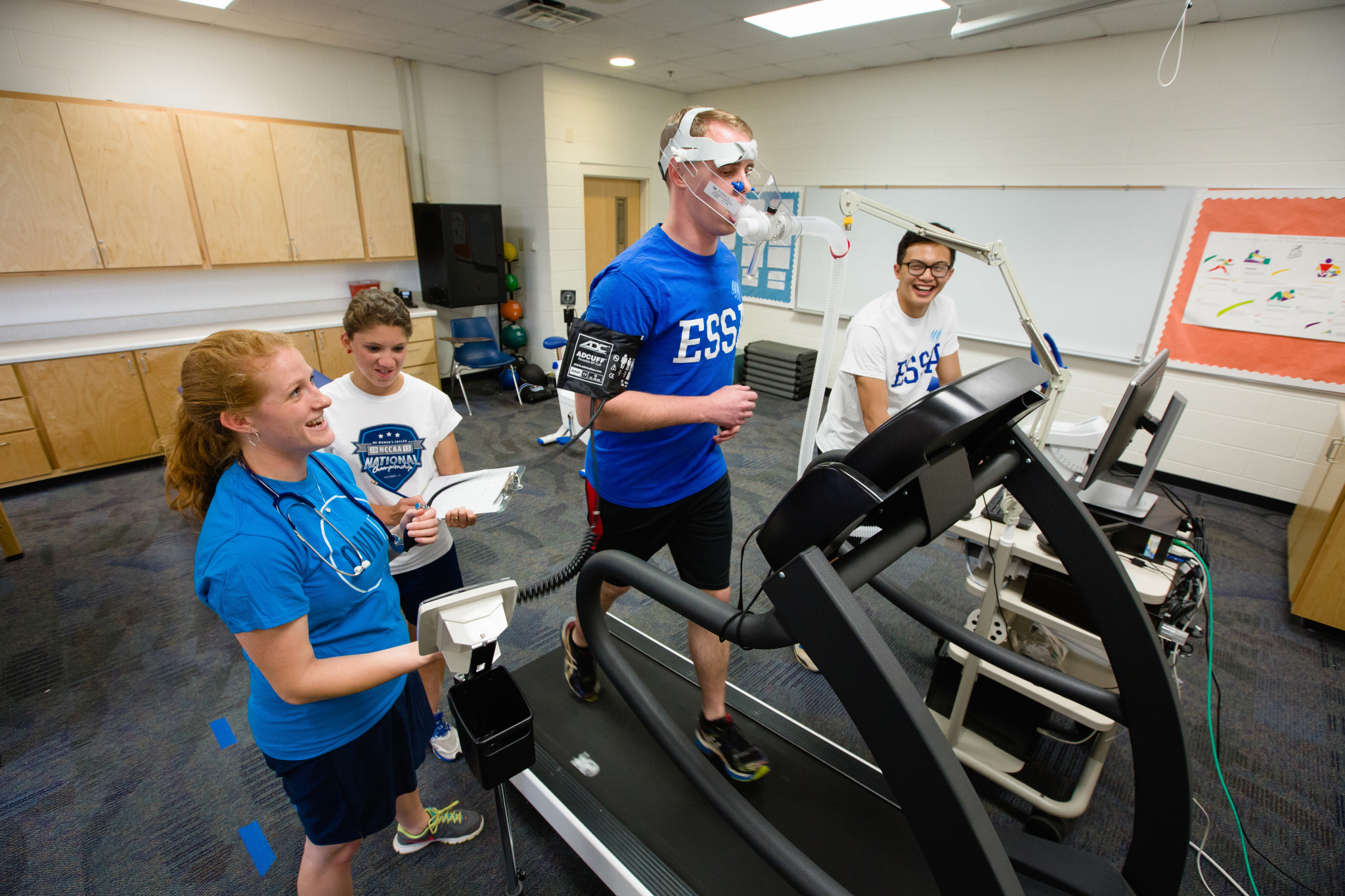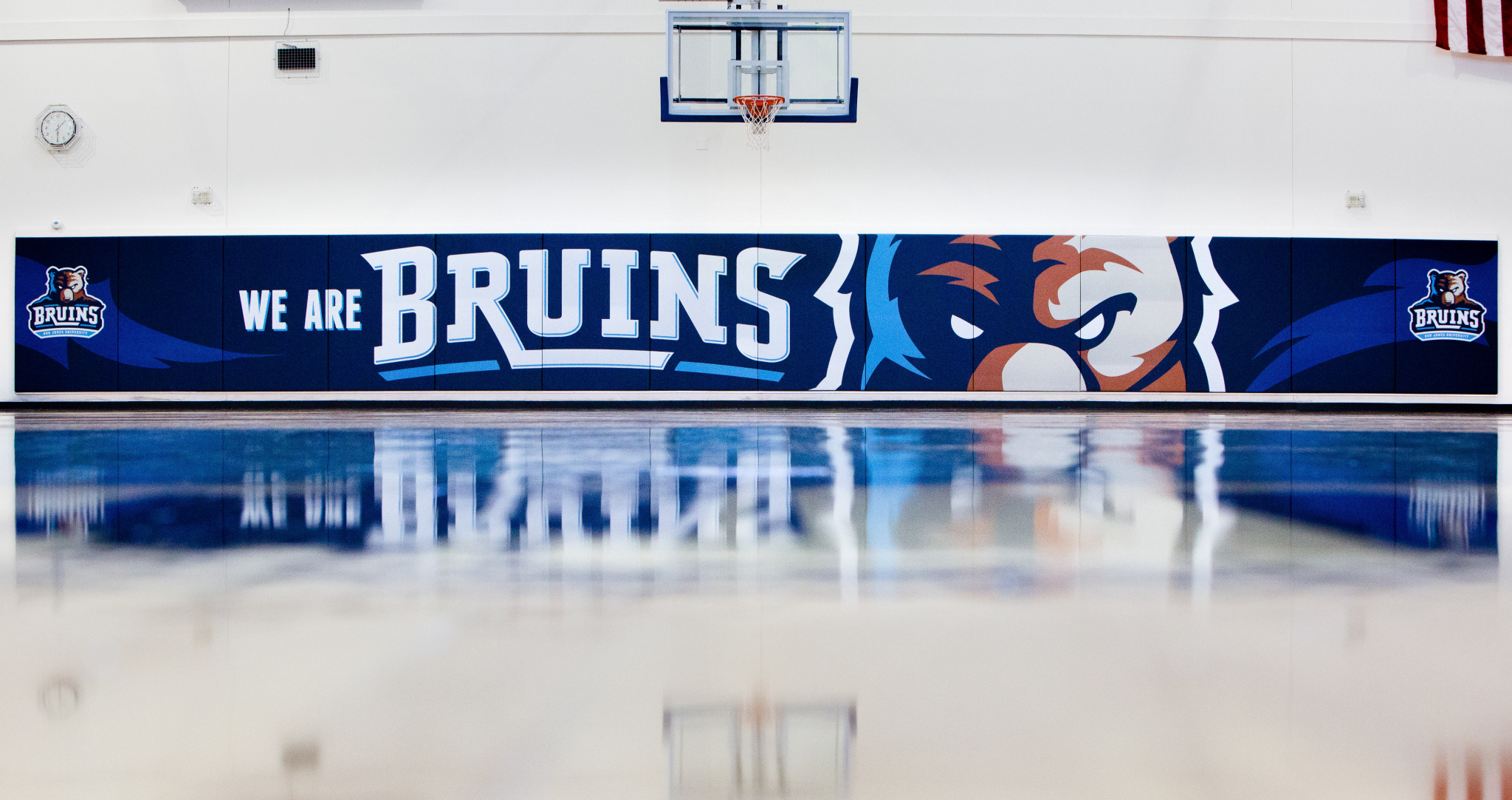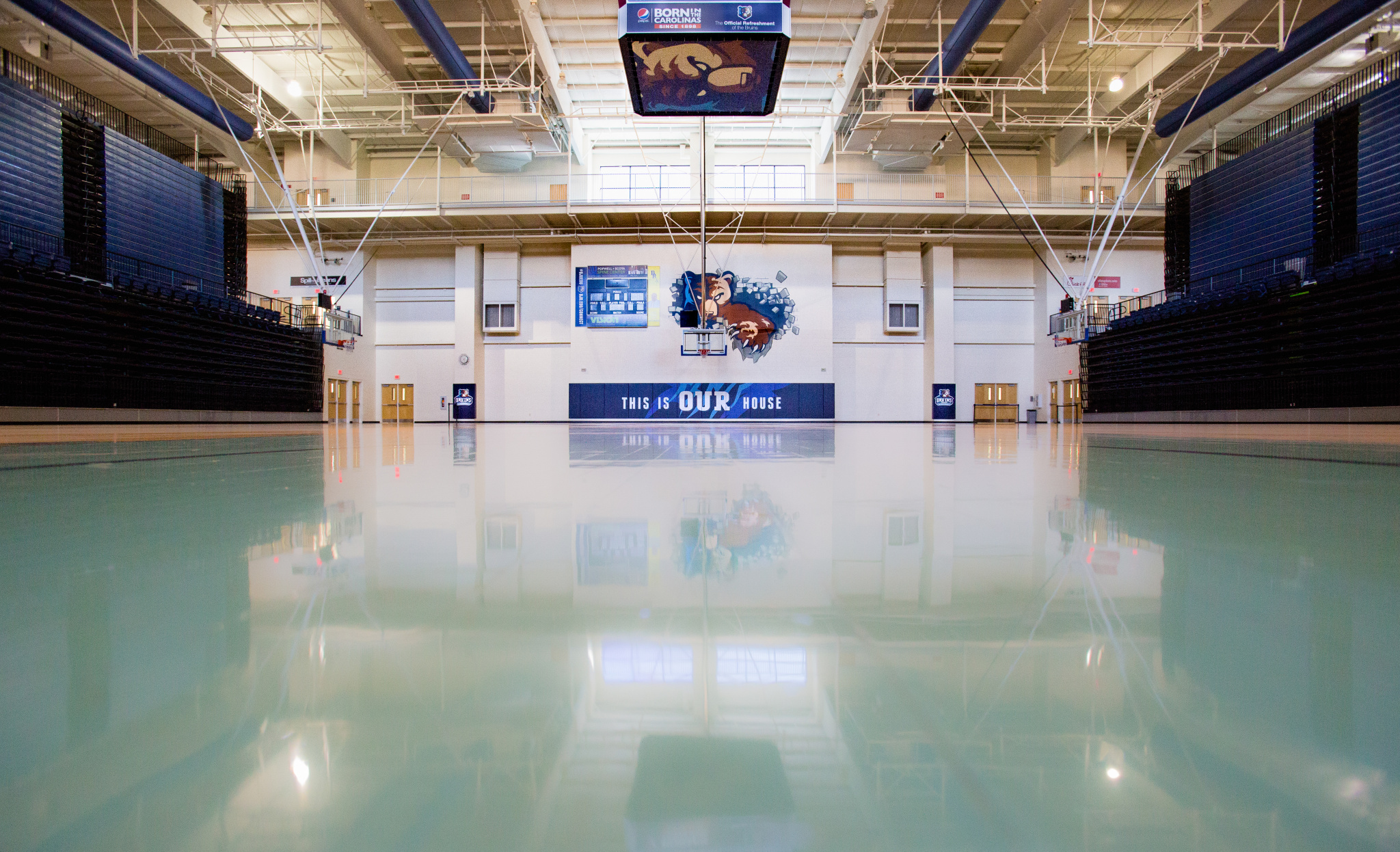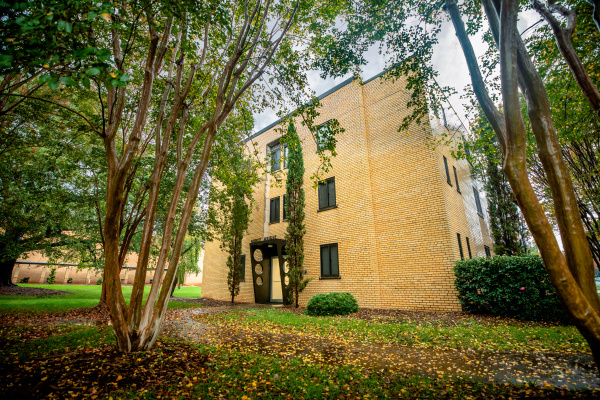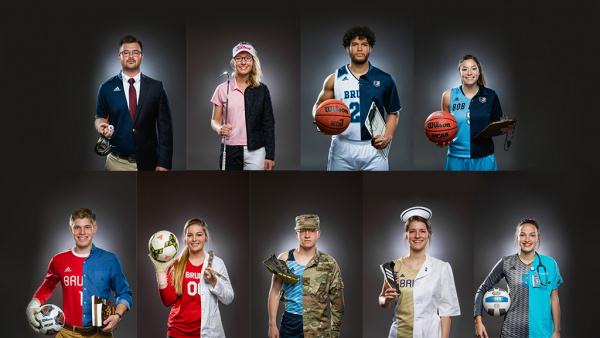The Davis Field House is a more recent addition to the BJU campus, but the University’s gymnasium has a long history.
The First Gymnasium
The gymnasium on the Greenville campus was originally in the building that is now Stratton Hall. It had a basketball court, two locker rooms where the stage now is, and offices upstairs. In addition to being the sports venue, the gym also served as the chapel venue until Rodeheaver Auditorium was completed in November 1947.
The Second Gymnasium
With a growing student population, the campus needed additional facilities. In 1955, the Executive Committee made plans to add several buildings to the campus, including a new gym. Fundraising began in May 1958, and the Class of ’58 even donated to the project as its senior gift. By September, ground was broken on the rise at the edge of the athletic field in preparation for the 30,000 square-foot building. A month later, the foundation was in place along with the buttresses for the arches that would form the roof. The eight laminated Douglas fir arches—spanning 150 feet and towering 33 feet—arrived in Greenville in sections on railroad flat cars. Their installation began in November and work continued until the gym’s completion in April 1959.
The end result was a multifaceted building much improved from the previous gym. Under the arches was the main court, which could be partitioned for practices. Seats could be extended to the main floor from balconies on two sides of the court, providing room for more than 2,000 people.
At the back of the gymnasium, a balcony overlooked the swimming pool in the adjoining natatorium. The regulation-size pool had one-meter and three-meter diving boards on one end. On the lower level of the natatorium, locker rooms with showers, steam rooms and equipment rooms flanked the pool. On the main level above, there was a room for corrective posture instruction, wrestling and men’s and women’s ping pong tables. This area also housed two offices and two classrooms. Additionally, the back of the gymnasium had a small sun-bathing area for men, accessible by an attic-like ladder.
The Class of 1959 gifted the original fountain, which featured 11 jets, four cascades, colorful lighting and a variety of sprays.
The Davis Field House
After over 40 years of use, the time came for the gymnasium to be replaced due to age and complicated schedules of over 40 societies. As Dr. Bob Jones III said, “It had served its generation.” In 2001, the process of designing the new building began. Preparation for funding was also underway—the 2001 and 2002 Bible Conference offerings were dedicated to raising money for the new building.
Demolition of the gymnasium began in April 2003—everything but the arches was discarded. With the influence of Daniel Cook—the architect of the DFH and founder of Building God’s Way—the arches became the Activity Center on the lower athletic fields. Soon after demolition, construction on the new facility began. Students served the workers by taking them refreshments while they were on the job. Once the contractors finished their work in June 2004, BJU staff completed stonework, painting and cabinetry. The building was finished that August and dedicated Sept. 4, 2004.
New and Improved
The 90,000 square feet of the Davis Field House holds many amenities similar to the old gym. But as Dr. James Deuink—then dean of the School of Education—said at its dedication, “It is everything that we had before with many enhancements.” One such enhancement is more basketball courts, eliminating the need for early morning practices for men’s societies. In addition to the main court that can be divided into two regulation courts, the DFH has two auxiliary courts. Each of the three courts has six retractable basketball goals. Not only are the courts capable of hosting four basketball games at once, but they can also hold four volleyball games or six badminton games.
The main court seats up to 3,000 people—900 in theater-style seats and 2,100 on benches. All seating is retractable. A suspended center scoreboard enhances the main court.
Other amenities improve the Davis Field House as well. At the back of the DFH is a 75- x 50-foot pool. On the lower level, the DFH also houses the women’s fitness center (relocated from the Fremont Fitness Center), women’s aerobics room and saunas. Upstairs, a one-seventh-mile, rubber-like indoor track encircles the courts. Men’s and women’s locker rooms and showers are available specifically for the pool and for other fitness areas. The Growl—previously the Fastbreak—is also at the main entrance, offering Grab ‘n’ Go lunches for students and concessions at games.
The Davis Field House also houses part of the Division of Exercise and Sport Science. There are four classrooms, each holding 30-35 students—twice the capacity of the former gym’s classrooms. And, two of the classrooms can combine into one large room. Six faculty offices are also located in the DFH.
With the introduction of intercollegiate athletics in the fall of 2012, the floor and walls received designs featuring Brody, the Bruins mascot.
David Dale and Velma Davis
David Dale “D.D.” Davis—born April 26, 1917, in Hubbard, Ohio—was an influential businessman. After serving in the U.S. Navy during World War II, Davis founded the D.D. Davis Construction Company, which was later succeeded by Davis International, Inc. in Youngstown, Ohio. Davis International, Inc. designs and constructs industrial buildings for cold storage and food processing.
His wife Velma (1916–2007) supported Davis’ ambitions. After her death, a Youngstown publication said, “Velma was there working right beside him in every aspect of the company.” Along with working together in business, the couple—married in June 1941—raised two daughters, one a 1964 BJU graduate.
A Life of Service
Davis used his resources to help others, both in his community and around the world.
In addition to serving on the BJU Board of Trustees, he served on the boards of the Butler Institute of American Art, Ravi Zacharias International Ministries—which his wife helped found—and Bank One of Youngstown. He also funded buildings in the Youngstown area, some of which were consequently named after him and his wife.
Not only did Davis serve the community, but he also served God. He and his wife were active in their local church. Davis also distributed Bibles with Gideons International on all seven continents, including Antarctica during a trip in January 2002. He also made sure to have fun on his travels. On his way to Antarctica, he passed through Brazil and hang glided at 84 years of age, and while in Antarctica he made sure to get a close look at the penguins.
Their daughter Bev said, “My parents’ testimony is one of putting God first in all things. We own nothing—God owns it all. He gives us gifts and talents; all we do is administer these things. My dad was a doer. ‘No’ was not in his vocabulary—all for the glory of God.”
Impact on BJU
BJU also recognizes the Davises’ lives of service. The plaque in the Davis Field House reads,
Mr. and Mrs. D. D. Davis enthusiastically believed in the University’s Christian educational mission. They loved and believed in the young people. This field house, a center for high-spirited competition, is a well-suited tribute to this Christian couple, whose lives were full of the Lord’s zeal and who strived mightily for the sake of the Gospel.
Christian businessman, industrialist, benefactor to economically-deprived nations, philanthropist, friend of Jesus Christ and His Gospel—Mr. Davis was also a partner with Bob Jones University as a member of the Board of Trustees for 31 years until his Homegoing on November 9, 2002.
Jones testified to their heart for BJU’s cause when he said at the dedication, “(The family was) very much involved in this institution. They have adopted this student body from this institution as one of those Christian causes that they love.”
The Davis Field House is a testimony of God’s grace because of the life of its dedicatees and his provision for the building itself. It was paid for before it was completed. Jones said, “This is a gift from the hands of God that we are going to try to use for his glory in the training of young people who will do his will and his work throughout their entire lives.”


